
The Noctuidae, commonly known as owlet moths, cutworms or armyworms, are a family of moths. They are considered the most controversial family in the superfamily Noctuoidea because many of the clades are constantly changing, along with the other families of the Noctuoidea. It was considered the largest family in Lepidoptera for a long time, but after regrouping Lymantriinae, Catocalinae and Calpinae within the family Erebidae, the latter holds this title now. Currently, Noctuidae is the second largest family in Noctuoidea, with about 1,089 genera and 11,772 species. This classification is still contingent, as more changes continue to appear between Noctuidae and Erebidae.

Noctuoidea is the superfamily of noctuid or "owlet" moths, and has more than 70,000 described species, the largest number of any Lepidopteran superfamily. Its classification has not yet reached a satisfactory or stable state. Since the end of the 20th century, increasing availability of molecular phylogenetic data for this hugely successful radiation has led to several competing proposals for a taxonomic arrangement that correctly represents the relationships between the major lineages.

The large ranunculus is a moth of the family Noctuidae. It is found in Europe and North Africa.

Caradrina clavipalpis, the pale mottled willow, is a moth of the family Noctuidae. The species was first described by Giovanni Antonio Scopoli in his 1763 Entomologia Carniolica. It is found in the Palearctic realm. It is an introduced species in North America, where it was first reported from Queens in New York City in 1993. In 2009 it was found in Rochester, New York, so it appears to be established and spreading.
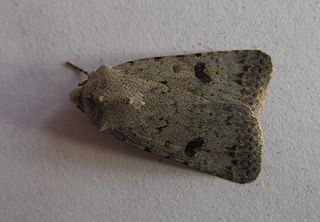
Paradrina rebeli is a moth of the family Noctuidae. The species was first described by Otto Staudinger in 1901. It is endemic to the Canary Islands. Some authors consider the genus Paradrina to be a subgenus of Caradrina, hence the species is also known as Caradrina rebeli or Caradrina (Paradrina) rebeli.
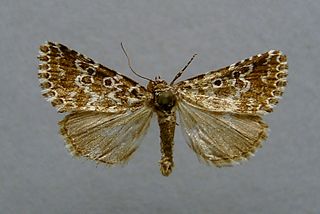
Alvaradoia is a genus of moths of the family Noctuidae.
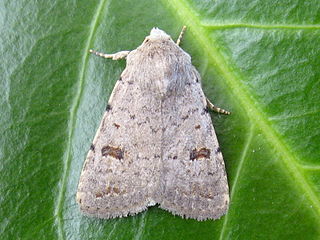
Caradrina is a genus of moths of the family Noctuidae, erected by Ferdinand Ochsenheimer in 1816 and divided into eight subgenera. These include Paradrina and Platyperigea, which some authors treat as separate genera. By 1989, it comprised 189 described species.
Haemerosia is a genus of moths of the family Noctuidae. The genus was erected by Jean Baptiste Boisduval in 1840.
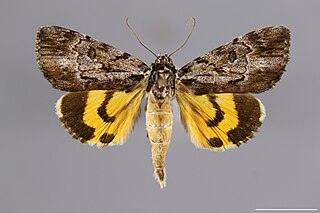
Catocala louiseae, or Louise's underwing, is a moth of the family Erebidae. The species is endemic to the United States. The epithet, louiseae, is in honor of "the late Louise Mellon" who funded the Carnegie Museum of Natural History expedition on which the type specimen was collected. The species was first described by John Bauer in 1965.
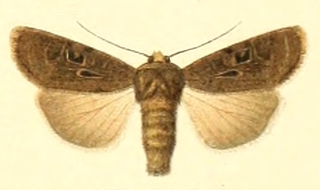
Chersotis andereggii is a moth of the family Noctuidae.

Caradrina multifera, the speckled rustic moth, is a moth of the family Noctuidae. The species was first described by Francis Walker in 1857. It is found in North America from Newfoundland to North Carolina and Tennessee and west to Minnesota and Manitoba. It is also present in British Columbia and Washington.
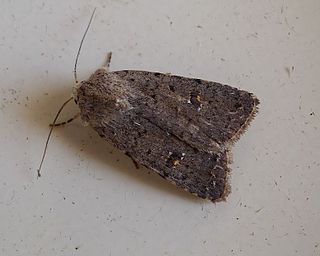
Caradrina flavirena is a moth of the family Noctuidae. It was described by Achille Guenée in 1852. It is found in Morocco, Algeria, southern Europe, Turkey, Israel, Lebanon, Jordan, Syria, Armenia and Iran. The habitat consists of grasslands.
Caradrina vicina is a moth of the family Noctuidae. It was described by Staudinger in 1870. It is found from Central and Southeastern Europe, eastern and central Anatolia, and Western to Central Asia. The habitat consists of grasslands.
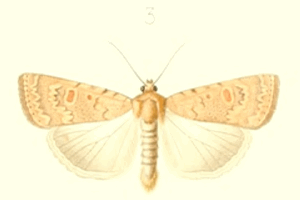
Caradrina flava is a moth of the family Noctuidae. It was described by Charles Oberthür in 1876. It is found in Spain and Greece and on Malta and the Canary Islands, as well as from the Sahara to the Arabian Peninsula, Israel, Jordan, the Levant, Iran and Iraq.

Coenotephria ablutaria is a species of moth in the family Geometridae. It was described by Jean Baptiste Boisduval in 1840. It is found in Spain, France, Italy, Austria, Switzerland, Slovenia, Bulgaria, Romania, Serbia, Croatia, Albania, North Macedonia, Greece, Ukraine, as well as on Sardinia, Corsica, Sicily, Malta, Crete and Cyprus. Outside of Europe, it is found in Asia Minor and the Near East.
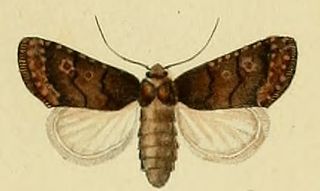
Caradrina germainii is a moth of the family Noctuidae. It was described by Philogène Auguste Joseph Duponchel in 1835. It is found in south-western Europe and North Africa. It is found mostly in garigue habitats.
Cucullia balsamitae is a moth belonging to the family Noctuidae. The species was first described by Jean Baptiste Boisduval in 1840.














